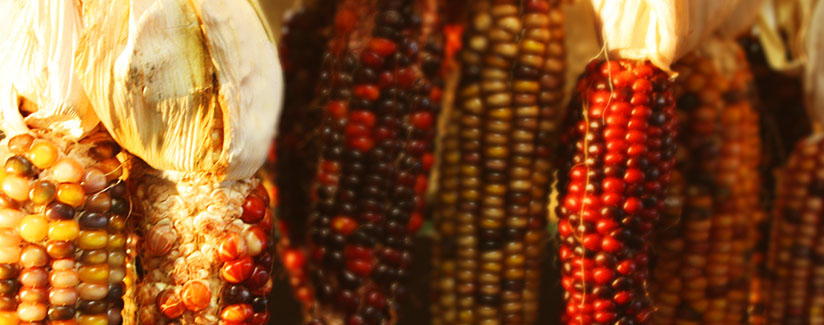
Sweet corn. Field corn. Popcorn. What’s the difference?
Let’s take a look at corn from all angles. Sweet corn, field corn, and popcorn – where do the different types of corn fit into your diet? We received a question concerning which type of corn fits in which category, and why. To answer the question we have reached out to three experts.
First, we reached out to Jen Haugen, RD, LD, from the blog Down-to-Earth Dietitian to get a basic overview of all three types of corn.
What’s the deal with corn? Is it a grain or a vegetable?
Haugen: “That depends on which type of corn you are talking about! Fresh corn, like sweet corn, is a vegetable. You can find it in the produce aisle in the summer when sweet corn season is in full swing, as well as canned and frozen year-round. Sweet corn is picked at an immature state, which is known as the milk stage. Because of this, sweet corn is sweet, rather than starchy, which reflects a higher percentage of sugar. Yet, this quickly reverses to more starch than sugar after it is harvested from the stalk, which is why eating sweet corn soon after it is picked is necessary for the best flavor.
Field corn, the primary corn planted in the United States, is also known as “dent corn” because a dent forms in the top of the kernel as it begins to dry on the stalk. Field corn is primarily used for animal feed. We also consume it in the forms of corn meal, corn starch and corn syrup. If you use corn meal, corn flour, grits or polenta, make sure it says “whole corn” or “whole grain corn” on the label to ensure it is a whole grain. Otherwise, it has just been “degermed,” which means the germ portion of the grain has been removed and therefore is no longer a whole grain.
Popcorn is yet another variety of corn that has a hard, moisture-resistant hull that surrounds a dense pocket of starch that will pop when heated. Popcorn is a whole grain.“
Are there health benefits from corn?
Haugen: “Corn is generally known for its vitamin A content, having more than 10 times the vitamin A when compared to other grains. It is also a major component in gluten-free products, because corn is gluten free. And recent research has found the antioxidants lutein and zeaxanthin in corn to be beneficial for eye health. In one ear of sweet corn, you will find about 90 calories, 18 grams of carbohydrate and 2 grams of fiber.”
Can corn become unhealthy?
Haugen: “Corn is the most consumed grain in the world. It is filled with nourishing nutrients, whether you consume it as a whole grain or as a vegetable. And there are a lot of myths that may persuade one to think that corn is unhealthy. Yet, whether you are trying provide healthy meals for your family, maintain a healthy weight, manage your blood sugars for diabetes or take care of your heart, corn is a healthy choice.
You may wonder about corn syrup or high fructose corn syrup – very simply, these are both sugar sweeteners made from corn. You might be surprised to know that our bodies process and metabolize corn syrup in the same way we process sugar or honey. And there is no difference in calories when comparing corn syrup and table sugar. As with all sweeteners, it is best to consume them in moderation and in conjunction with a balanced diet of fruits, vegetables, lean protein, whole grains and low-fat dairy.”
Read on about facts for high fructose corn syrup.
For insights from a popcorn farmer, we reached out to Lauren Shissler from the Growing on Goofy blog.
How did you get started in the popcorn production business?
Shissler: “I got started when I married into a family of farmers! My husband is a 7th generation farmer and his grandpa got started in the popcorn business by simply buying popcorn seed and growing it, then packaging it after harvest. Today, we grow popcorn for Weaver Popcorn and Great Western Popcorn.
In this area, popcorn is a perfect crop – and we grow yellow popcorn. We have many irrigators and this is very conducive to popcorn growing, as the popcorn companies look for very specific amounts of water being available to the plants.”
Can you tell us about your growing and harvesting process, and how it would compare to growing other types of corn like field corn, or sweet corn?
Shissler: “The growing and harvesting processes are the same for popcorn and field corn. The main difference is that we have a very particular moisture level at which the popcorn is harvested. It’s important that it’s not too wet or too dry – as with either extreme, it won’t pop.”
How do you manage weeds and other insects?
Shissler: “We manage weeds and other insects by spraying herbicides and insecticides, if needed.”
How do you store the popcorn?
Shissler: “It’s stored in a bin, just like field corn, and it will stay fresh for up to one year.”
What food group would you classify popcorn in?
Shissler: “Popcorn is classified as a grain.”
Lastly, we reached out to John Comerford, PhD, to hear his input on whether corn is a grain, a grass or a vegetable. He explained that corn is all three; the corn plant is a grass, the seed is a grain, and in the human diet corn would be classified as a vegetable.
Taking a look from a different perspective, Dr. Comerford explains that corn is a staple of livestock and poultry feed because it can produce the most feed energy per acre. The primary use of corn in animals is poultry, followed by hogs, then cattle.
Comerford: “I can legitimately sit on the fence on this one!”
References:
//www.bestfoodfacts.org/true-or-not/true_not_highfructosecornsyrup
http://wholegrainscouncil.org/whole-grains-101/types-of-corn
“indian corn” by Phera Laster is licensed under CC BY.


























